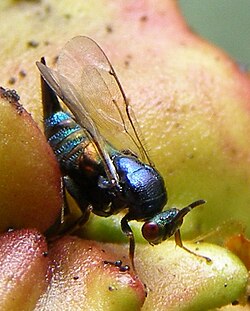| Ormyridae | |
|---|---|
 | |
| Ormyrus sp. | |
| Scientific classification | |
| Kingdom: | Animalia |
| Phylum: | Arthropoda |
| Class: | Insecta |
| Order: | Hymenoptera |
| Superfamily: | Chalcidoidea |
| Family: | Ormyridae Förster, 1856 |
| Genera | |
Asparagobius Contents | |
The Ormyridae are a small family of parasitic wasps in the superfamily Chalcidoidea. They are either parasitoids or hyperparasitoids on gall-forming insects, [1] primarily cynipid wasps and tephritid flies. There are 153 species, mostly in the genus Ormyrus ); [2] the family has a worldwide distribution, although almost entirely absent from South America.
Some can be recognized by distinctive scalloped sculpturing of their metasomal tergites. Adults of many species are iridescent. [3]